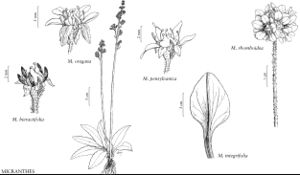Micranthes hieraciifolia
Saxifrag. Enum., 45. 1821 (as hieracifolia) ,.
Plants mostly solitary, with short caudices, sometimes rhizomatous. Leaves basal; petiole sometimes indistinct, flattened, 2–4 cm; blade ovate to elliptic, 2–6 cm, ± fleshy, base cuneate to slightly attenuate, margins usually ± evenly serrulate to denticulate, ciliate, surfaces sparsely to densely hairy and sparsely stipitate-glandular. Inflorescences 30+-flowered, constricted, spikelike thyrses, 7–30 cm, tangled-hairy proximally, densely purple-tipped stipitate-glandular distally. Flowers: sepals spreading to reflexed, triangular to ovate; petals dark reddish purple, not spotted, narrowly ovate to lanceolate, slightly clawed, 1.5–3 mm, equaling sepals; filaments linear, flattened; pistils connate to 1/2 their lengths; ovary 1/2+ inferior. Capsules reddish to purple, valvate. 2n = 112, 120.
Phenology: Flowering summer.
Habitat: Wet, mossy tundra, streamsides, ledges, crevices
Elevation: 0-2000 m
Distribution

Greenland, B.C., N.W.T., Nunavut, Yukon, Alaska, Mont., Europe, Asia
Discussion
In British Columbia, Micranthes hieraciifolia is disjunct between the far north and the Okanagan-Thompson Plateau in the south (S. A. Harris 2003).
Selected References
None.
Lower Taxa
"full" is not a number.
